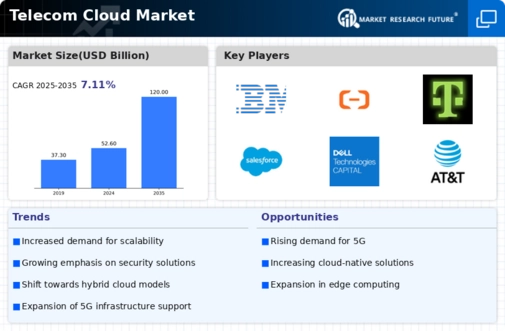Market Trends
Key Emerging Trends in the Telecom Cloud Market
There are a number of noteworthy developments in the telecom cloud market that highlight how the telecom sector is still evolving. The growing use of Multi-Access Edge Computing (MEC) in combination with Telecom Cloud technologies is one noteworthy development. By bringing computing power closer to the edge of the network, MEC lowers latency and makes it possible to handle data from connected devices more effectively. Utilizing MEC, telecom operators are able to support new technologies like augmented reality, virtual reality, and the Internet of Things (IoT) while also improving the performance of their apps and services.
The industry's emphasis on providing high-performance, low-latency solutions that meet the requirements of a variety of use cases is reflected in this trend. One revolutionary development influencing the telecom cloud is the combination of artificial intelligence (AI) and machine learning (ML) technology. In order to improve overall operational efficiency, anticipate and avoid network problems, and optimize network management, telecom operators are progressively integrating AI and ML algorithms into their cloud solutions. These technologies are essential for process automation, better decision-making, and insight-based proactive network maintenance.
The trend demonstrates the industry's dedication to using the Telecom Cloud's intelligent solutions to handle the complexity of today's sophisticated telecommunications networks. One major factor impacting the telecom cloud industry is the development of 5G technology. The need for cloud-native architectures that can handle 5G's enhanced bandwidth, low latency, and scalability needs is rising as 5G networks continue to roll out internationally. In order to implement virtualized network operations and create a more adaptable and agile network architecture, telecom operators are using cloud-native techniques.
This trend shows how 5G and Telecom Cloud solutions work well together, with cloud-native designs becoming essential to use 5G connection to its maximumest. In the telecom cloud sector, hybrid and multi-cloud techniques are becoming more and more popular. Telecom operators are balancing performance, scalability, and cost-effectiveness by implementing a hybrid strategy that incorporates public and private cloud technologies. Multi-cloud methods also make use of services from several cloud providers in order to improve resilience and prevent vendor lock-in. The industry's realization of the value of choice and flexibility in cloud deployment options to accommodate the various requirements of changing telecom networks is shown in this development.

















Leave a Comment